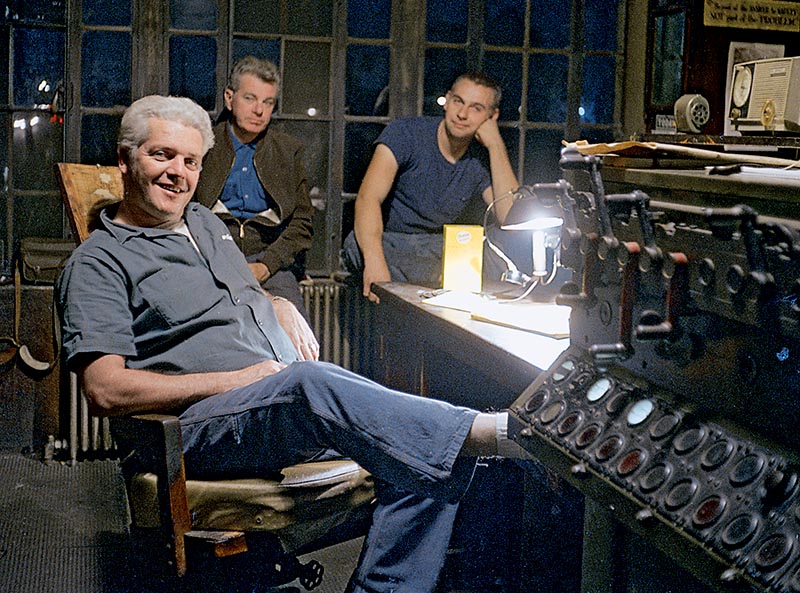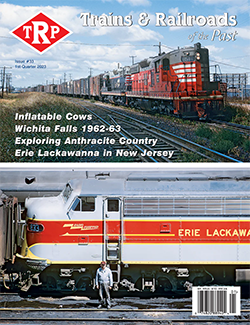 by Jim Gerofsky with Mike Galesi/photos as noted
by Jim Gerofsky with Mike Galesi/photos as noted
In 2009, railroad author Bob Mohowski published an article in the Erie Lackawanna Historical Society’s Diamond about growing up as an Erie enthusiast in Rutherford, N.J. (Vol. 23, No. 2). Watching trains gave Bob the inspiration for a “long journey” into a world of expanding horizons for both body and mind. As an adult, he left the Rutherford area and traveled widely across the nation and the world. He encountered a wide variety of people during his travels. In the Diamond, Bob said that these people were an education in themselves and helped to shape his life. Bob has shared many of his adventures and discoveries with us through his long list of railroad books and articles.
I, likewise, grew up near Rutherford and was inspired by the railroad to make a long journey of body and mind. As with Bob Mohowski, I’ve met many interesting men and women along the way. But looking back, it turns out that I didn’t need to travel very far to find them! During my teen years along the five-mile “Erie wishbone” from the Hackensack River bridge to the Passaic River bridge on the Main Line and the Saddle River viaduct along the Bergen County Line, I got to know many railroad people. They seemed ordinary back then, nothing special. But I now realize how remarkable they really were.
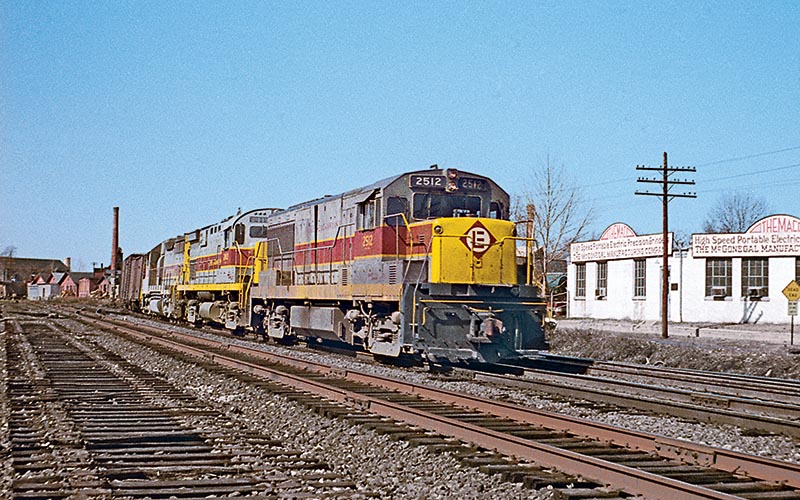
ABOVE: An eastbound freight is rounding the curve on the Bergen County Line that leads into Rutherford Junction. It has just passed the eastbound home signal for BJ interlocking, seen just to the right of the smokestack. This freight is displaying the best of the EL’s early purchases of second-generation power from each builder: General Electric U25B 2512, leading an ALCO C424 and an EMD GP35. The numberboards on the cabs are still in the early-EL style, dark with white lettering. After Norfolk & Western proxy control of the EL was established through Dereco in 1968, EL road units received white numberboards with black lettering, the standard for the N&W system. —Photo by Jim Gerofsky.
The Setting
Along the right-of-way that ran through Rutherford, the scenery ranged from the barren meadowlands that surrounded HX Tower near the Hackensack River to the busy stores along Park Avenue near the passenger station (telegraph name “RV”). Continuing west, the Erie paralleled tree-lined streets and suburban houses to BJ Tower at Rutherford Junction.
The Main Line then continued another 3/4 of a mile into Carlton Hill, where a chemical factory, a cloth bleachery and a truck-ing company depot interrupted the pleasant residential character of the neighborhood. After passing Carlton Hill station (telegraph “HN”) and the sidings that served those industries, the rails proceeded along a rising embankment surrounded by vacant wooded lots and oil storage tanks. They finally reached the bridge over the Passaic River (telegraph “BE”) and entered the urban precincts of Passaic. Moving back to BJ, the Bergen County freight cut-off swung to the northwest, immediately entering a two-mile factory zone where few roads crossed or came near the line.
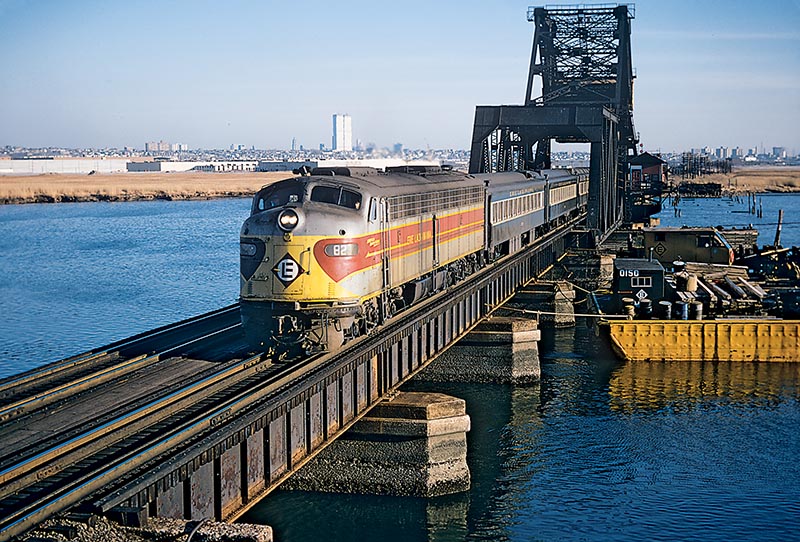
ABOVE: Train 57 is crossing HX drawbridge and about to pass HX Tower on March 20, 1973. The World Trade Center is clearly visible in the background and it’s very possible that some of the commuters on board this train worked for the financial companies that were located there. The train is heading west on the eastbound track, which is signaled for bi-directional movement as far as BJ. This allows westbound passenger trains to stop at Rutherford on the eastbound platform; this was the preferred track for all trains stopping there. Train 57 will then crossover back to the westbound Bergen County Line track at BJ Tower, which by this time was controlled from HX Tower. Mike Galesi is standing at the upstairs door for this photo.
Aside from a supermarket at the Paterson Plank Road crossing (where I watched freights and evening commuter trains while my parents shopped for groceries), the Bergen County Line was mostly hidden from public view, only emerging as it crossed the Saddle River into Garfield. There are stories of hobo camps along this part of the Line during the 1930s and 40s.
So, within less than ten route-miles there was a wide variety of buildings, signals, sidings and other facilities. These included the steam-powered BE swing bridge at the Passaic River, the bascule lift bridge over the Hackensack, the fairly modern BJ and HX interlocking towers, a relatively large orange brick passenger station of elegant design at Rutherford, the more humble wooden depot at Carlton Hill, two manned crossing gatehouses, a red-brick freight house (closed in 1964), two team tracks and an unloading area, a variety of signal masts and bridges, and a spaghetti-bowl of sidings serving a variety of trackside industries. A special memory I have was the annual appearance of forest green Maine Central boxcars at the team tracks every December that were laden with Christmas trees! Occasionally, I would notice an antiquated Wellsville, Addison & Galeton wooden boxcar being unloaded there.
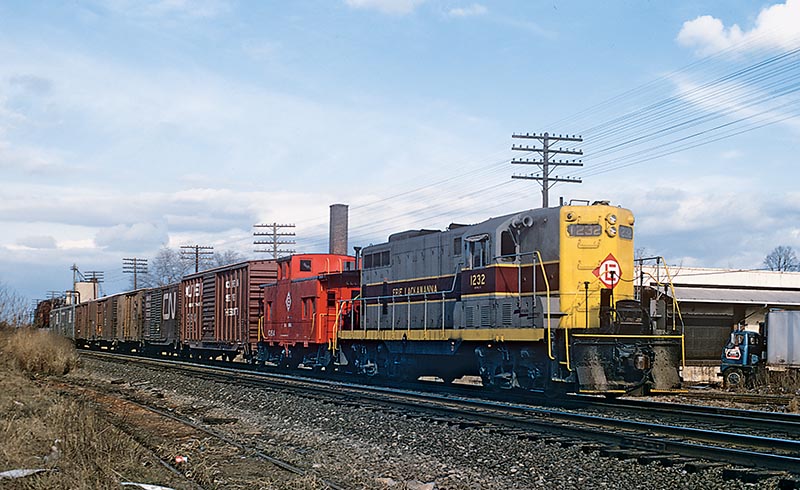
ABOVE: The Rutherford Drill is seen here on the Bergen County Line to the north (railroad west) of Rutherford Junction in February 1973. This shot was taken in mid-afternoon after the Drill had finished switching the various industries that parallel the westbound main line on the County Line. The crew had obtained the dispatcher’s permission to occupy the westbound main track, with permission to run east against traffic. This was based upon a “block” that the operator at HX had temporarily established using the westbound home signal at BJ (by this time, BJ was controlled from HX). The operator placed some sort of physical device on the signal lever to remind him not to clear the westbound home signal and not let a train past it; this allowed the train ahead to exclusively occupy the “block” and move whichever way it liked. GP7 1232 soon got the Drill to BJ and vacated this “block,” allowing restoration of normal operations. The Drill then crossed over to the Carlton Hill branch and continued its switching duties into the early evening. —Kodachrome by Jim Gerofsky.
The Heritage
In mid-1832, the Paterson & Hudson River Railroad completed a horse-drawn rail line between Paterson and Passaic, and a year later extended the route through Rutherford and into Jersey City. After the coming of the railroad, Rutherford slowly changed from a farming village into a bedroom community for Manhattan commuters and a home for mixed industry.
In 1835, the P&HR started replacing its horses with steam locomotives. The line was extended west in 1848 via the Paterson & Ramapo Railroad to a near-connection with the Erie’s initial route from Piermont on the Hudson River to Dunkirk on Lake Erie. The final mile of that connection was completed in 1852. The P&HR and P&R were then absorbed into the Erie by long-term lease. Rutherford became an Erie town…


